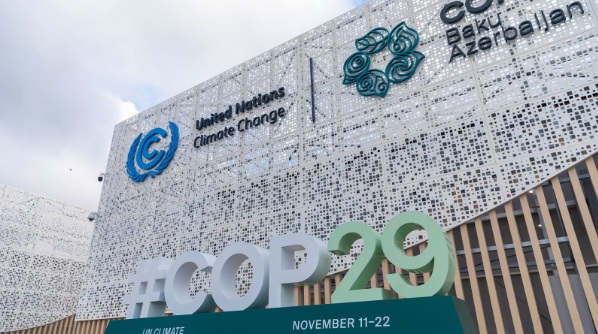- The 29th Conference of the Parties (COP-29) under the United Nations Framework Convention on Climate Change (UNFCCC) was held in Baku, Azerbaijan.
- The conference provides a global platform for countries to coordinate efforts, ensure financial and technical support, and enhance transparency and accountability in climate action.
- COP-29 resulted in several significant agreements and declarations that are expected to be milestones in global climate policy, financial targets, energy transition, carbon markets, and socio-cultural initiatives.

COP-29 Overview
- COP-29 set a new direction for global climate action.
- The conference’s goal was not only to reduce emissions but also to enhance cooperation between developed and developing countries in finance, technology, and policy, include local and indigenous communities, and strengthen the principle of climate justice.
Key Outcomes and Themes of COP-29
1. Climate Finance: New Collective Quantified Goal (NCQG)
- NCQG was recognized as a major achievement at COP-29.
- Proposed under Article 9 of the Paris Agreement (COP-21), it obliges developed countries to provide financial support to developing countries.
- Target: USD 300 billion per year by 2035.
- Previous goal: USD 100 billion per year by 2020, later extended to 2025.
- Funds are aimed at adaptation and mitigation activities, including clean energy projects, climate-resilient infrastructure, and climate justice initiatives.
- Important Note: The required global investment by 2030 is USD 6.3–6.7 trillion, indicating that NCQG remains relatively modest.
Carbon Markets and Article 6
- COP-29 finalized rules for Article 6 of the Paris Agreement.
- Article 6 provides a structured mechanism for international carbon markets.
- Objectives: streamline the trading of emission reduction projects and carbon credits, ensure transparency and accountability, and provide financial incentives for emission reductions.
Transparency and Enhanced Transparency Framework (ETF)
- The Enhanced Transparency Framework (ETF) was another major focus.
- Under ETF, countries submit Biennial Transparency Reports (BTRs).
- COP-29 marked the submission of the first BTRs.
- Baku Declaration and the Global Climate Transparency Platform were launched to enable data-driven decision-making and global accountability.
Adaptation and Mitigation
- Adaptation and mitigation were placed at the center of the global agenda.
- Baku Adaptation Roadmap and High-Level Adaptation Dialogues were initiated, strengthened under the UAE Framework for Global Climate Resilience.
- Mitigation efforts continue under the Sharm El-Sheikh Mitigation Goals and Implementation Work Programme.
- Objectives: reduce climate-related risks, enhance disaster preparedness, and accelerate energy transition.
Indigenous Peoples and Local Communities
- Participation of indigenous peoples and local communities received special focus.
- Baku Workplan was adopted.
- The Facilitative Working Group (FWG) of LCIPP was given new responsibilities.
- Originally established at COP-24, FWG has been revitalized to better integrate local knowledge and experiences into climate policy.
Gender and Climate Change
- The Enhanced Lima Work Programme was extended for the next 10 years.
- The program incorporates gender-sensitive approaches into climate action.
- Policies and projects will be designed to address women and gender diversity considerations.
Major Initiatives and Declarations Launched at COP-29
-
Methane Reduction from Organic Waste: Targets set for methane emission reduction across sectors (India not a signatory).
-
Global Energy Storage and Grid Resolution: Aim to reach 1,500 GW of energy storage by 2030, six times the 2022 level.
-
Hydrogen Declaration: Promote clean hydrogen production and use.
-
Climate Finance Action Fund (CFAF): Provides financial and technical support for climate projects in developing countries.
-
Global Matching Platform (GMP): Offers technical and financial solutions for decarbonization of high-emission industries.
COP29 and India: India’s Stance in Global Climate Negotiations
- The 29th Conference of the Parties (COP29) to the United Nations Framework Convention on Climate Change (UNFCCC) was held in Baku, Azerbaijan.
- Almost all countries of the world participated in this conference to discuss climate change, emission reduction, and sustainable development issues.
- On this important global platform, India presented its strong and balanced stance, clearly signaling that it is a robust advocate for the perspectives of developing countries and their right to development.
India’s Stance and Key Aspects
1.National and Global Climate Finance (NCQG)
- India proposed a climate finance target of USD 1.3 trillion annually at COP29.
- Approximately USD 600 billion of this should come as grants or grant-equivalent resources.
- This initiative puts pressure on developed countries to ensure financial support for developing nations.
2.Mitigation
- India opposed changes to the Mitigation Work Programme (MWP) and attempts to revise the Paris Agreement temperature goals.
- India urged developed countries to formally acknowledge the mitigation gap prior to 2020.
- This reflects India’s position that developed countries must take responsibility for their emissions.
3.Just Transition
- India emphasized that developed countries should provide financial and technical assistance to developing nations.
- The development rights and sustainable priorities of developing countries must be fully respected.
4.Global Stocktake (GST)
- Referring to the Paris Agreement framework, India opposed any follow-up mechanism for the outcomes of the Global Stocktake.
- India also criticized the UAE Dialogue text for giving insufficient attention to financial issues and focusing mainly on mitigation.
5.Adaptation
- India suggested that clear indicators should be used to measure progress on adaptation.
- Only data provided by Parties (countries) should be used; third-party databases should not be relied upon.
6.Voice of the Global South
India launched two major initiatives at COP29 to strengthen the interests of Global South countries:
-
- Disaster-Resilient Infrastructure: Organized by India and the Coalition for Disaster Resilient Infrastructure (CDRI).
- Energy Transition: In collaboration with the International Solar Alliance (ISA), focusing on renewable energy and sustainable energy transition for the Global South.
|
Brief Information on UNFCCC(United Nations Framework Convention on Climate Change)
Headquarters: Bonn, Germany
Established: 1992, at the Rio de Janeiro Earth Summit; adopted in 1994
Significance: UNFCCC is the foundational convention for the Kyoto Protocol (1997) and the Paris Agreement (2015)
Other Rio Conventions: Convention on Biological Diversity (CBD) and United Nations Convention to Combat Desertification (UNCCD)
Key Challenges in Climate Negotiations
- NCQG targets are insufficient compared to the required global investment by 2030 (USD 6.3–6.7 trillion).
- Lack of consensus on the future share of fossil fuels in the energy mix.
- Slow operationalization and inadequate financing of the Loss and Damage Fund (LDF).
- Postponement of the next round of NDCs before COP-30.
- Influence of fossil fuel industry lobbyists on negotiations.
Conclusion
To limit global temperature rise to 1.5°C:
- 42% emissions reduction by 2030 compared to 2019 levels.
- 57% emissions reduction by 2035.
Necessary Actions:
- Expansion and robust implementation of NDCs.
- Support through sector-specific commitments and investments.
- Strong commitment to ‘Common but Differentiated Responsibilities and Respective Capabilities (CBDR-RC)’ and climate justice in climate diplomacy.
COP-29 made it clear that climate change is not only an environmental challenge but also deeply linked to global economic, social, and political stability. Addressing it effectively requires global cooperation, transparency, and shared responsibility as guiding principles.




